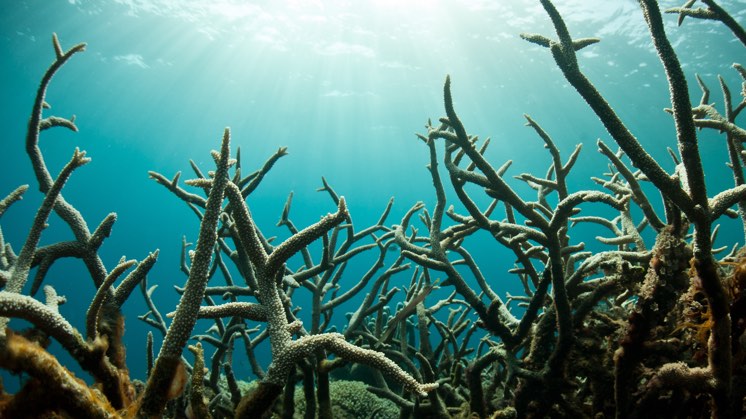Ocean acidification
Ocean acidification: why does it happen and what are the consequences?
The carbon dioxide (CO2) emissions we release into the atmosphere not only worsen air quality, but also have an impact on the health of the oceans. Specifically, they cause a phenomenon known as acidification, which reduces the pH of the water, modifying its chemical composition and seriously affecting marine organisms. Solutions include reducing the use of fossil fuels in favour of renewable sources.

Climate change is a fact of life, and is proof of the impact of much human activity on the health of the planet. Although the commitment to sustainability and the environment has improved in recent years, the challenges are numerous and they include the pollution of the oceans -of particular concern is the presence of plastics- and their acidification. Below we will discuss this phenomenon, its causes, consequences and possible solutions.
What acidification is and why does it occur
First of all, we need to be clear about some concepts related to chemistry. Water can be of three types: acidic (if the pH is below seven), neutral (if the pH is seven) or alkaline (if the pH is above seven). That is, the lower the level of pH in water, which is measured on a scale from 0 to 14, the more acidic it is. The surface of the oceans, taken as a whole, has a pH ranging from 8.0 to 8.3. The marine organisms have developed and evolved in a environment have done with these pH values, so they are adapted to this ecosystem and any change may threaten their survival.
Ocean acidification occurs when, through a set of chemical reactions, seawater absorbs CO2. As the United Nations Development Programme (UNDP) itself points out in an article, this has its positive side: if it did not occur, the presence of CO2 in the atmosphere would be 30 % higher, which would further drive climate change. Solving this problem is therefore inextricably linked to reducing emissions and can only be tackled globally, which makes it difficult to find solutions and make decisions.

SEE INFOGRAPHIC: The link between increasing pollution and ocean acidification [PDF]
Causes of ocean acidification
If we stick to the explanations given above, we could say that the main cause of ocean acidification is CO2 released into the atmosphere. Since the beginning of the Industrial Revolution, the concentration of this gas has increased severely due to the burning of fossil fuels used for industrial processes, power generation or transport, among other human activities.
In particular, CO2 levels in the atmosphere have increased from 250 to 400 parts per million (ppm) over the past centuries and, as a consequence, the pH of surface ocean water has decreased by 0.1. This may seem insignificant, but it represents a 30 % increase in ocean acidity compared to pre-industrial times. At current levels of fuel burning, pH is projected to decrease by a further 0.3 to 0.4 units, a rate not seen in at least the last 25 million years and an unprecedented rate in the history of the planet.
Consequences of ocean acidification
Who is affected by ocean acidification and how? According to Oceana, a marine conservation NGO, we could categorise these consequences as follows:
 | On marine life
| On marine life
There is a decrease in the amount of carbonate ions in the water, an element necessary for the formation of the skeletons and shells of certain marine animals. This situation could therefore affect their development and reproductive capacity, endangering their populations. The species most threatened by this phenomenon are crabs, lobsters, clams, oysters, etc.
We must also take into account their impact on other lesser-known species, such as pteropods, which play an important role at the food chain as a source of food for fish, cetaceans and birds. Corals, which act as a refuge for a quarter of marine species, are highly sensitive to acidification.
 | On human life
| On human life
A widespread decline in fish and shellfish populations due to acidification would severely impact one of the main sources of protein for millions of people around the world. As a consequence, the livelihoods of some 47.5 million fishermen and an industry that employs another 120 million people would be jeopardised.
Solutions to acidification of the oceans
At the global level, the main solution is to reduce CO2 emissions into the atmosphere, which are a direct consequence of human activities. To this end, processes such as the energy transition and decarbonisation are essential to minimising greenhouse gas emissions and achieving carbon neutrality, a commitment made by hundreds of countries in the Paris Agreement.
Specifically, according to Oceana, for the oceans to return to normal, we need to stabilise CO2 concentrations at 350 ppm or less, which in turn would mean reducing global emissions by 80-90 % by 2050. Such an ambitious goal will only be achieved through a large-scale shift from fossil fuels to renewable energy sources on a massive scale.
Science, meanwhile, is also looking for solutions. For example, research is underway to study how macroalgae can be used to store carbon and reduce acidification. Adapting fishing areas to reduce pressure on ecosystems or identifying which ocean areas are in urgent need of conservation can also help to combat this problem.




